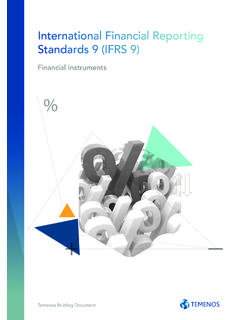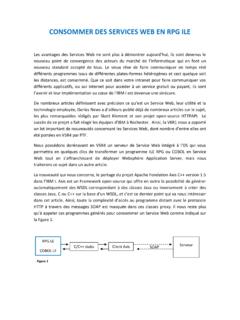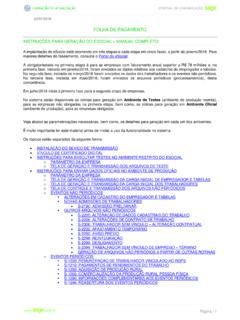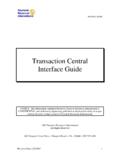Transcription of Interaction technology - Temenos
1 InteractiontechnologyOpen up your banking platform to accelerate the pace of innovation around your technologyOpen up your banking platform to accelerate the pace of innovation around your do our customers want and need?Collaborate with innovation partnersManage multi-device/channel UIsefficientlyEvolve cost-efficiently with customer Interaction preferencesCreate and distribute innovative combined servicesMarket backgroundThe omnipresence of internet and the spread of virtual and mobile channels have turned customers into direct users of banking systems.
2 Because banking customers are familiar with the great virtual experience offered by the likes of Amazon and Apple, they expect no less from their bank: assisted or non-assisted access 24/7 to banking services via a wide range of interfaces, channels and devices. Digital customers expect their banking experience to go beyond simple banking. Consumers also expect banking services to be available via non-banking channels for instance, real-time mortgage proposals on a real estate agents website or home-search app.
3 The implication is that banks have to cost-efficiently deliver services from multiple underlying business systems via multiple interfaces, channels and devices and not only their own, but third-parties .When banks try to do this, it usually comes at a significant cost. The main reason is that banks write complex code linking up business systems and user-interfaces, rigidly binding them to one another. Furthermore, as user-interfaces need to evolve much faster (typically every 3 years or so1) than underlying business systems (as seldom as every 15 years)2, banks regularly have to rip out and re-write these coded links and as many times as there are user-interfaces, channels, devices, user roles, etc.
4 This is obviously extremely costly and rigid approach also inhibits innovation around the bank s services because they are not readily available in a standardized way to third-parties. In other words, the bank is not open . Partners with user-experience expertise, superior knowledge of a customer segment or exploitable customer bases cannot create differentiated user-interfaces around the bank s services to boost their distribution. Similarly, the bank cannot easily tap services from third-party businesses to create innovative combined limitations make banks more vulnerable to disruptive fintech competitors which offer outstanding digital services and experiences that go beyond simple banking.
5 1 Source: Nielsen Norman Group2 Source: SOFGENI nteraction technologyValue propositionThe Interaction offering provides a highly flexible and open banking platform which accelerates the pace of innovation around the banks services, mitigating the threat of disruptive competition. The products in the Interaction offering enable banks to: easily expose banking services to innovation partners and to any user-interface (UI); create innovative combined services; undertake highly efficient multi-device/channel UI technologyBusiness benefitsTemenos Interaction offering makes the bank much more competitive, flexible and cost-efficient.
6 Ultimately, it enables the bank to mitigate the threat of disruptive competition and remain Design Studio for APIs, the bank can easily make its services readily available to innovation partners and to any user-interface (UI) or app of its choosing. This enables the bank to accelerate the pace of innovation around its services by collaborating with partners that have superior user-experience expertise and a better understanding of certain customer segments. By also using the User-Experience Platform, banks can create innovative UIs that combine services (banking and non-banking) from inside and outside the bank.
7 The principal business benefit is implementing the Interaction Framework, which leverages our Interaction products and standard third-party tools ( SCM) to provide an internet-like network of business systems and user-interfaces, the bank can stay apace with customer requirements much more easily. By enabling the bank to implement truly ReSTful architecture1 and make its banking services readily available in a standard manner (APIs) to any UI, the Framework lets user-interfaces and underlying business systems evolve at different paces without requiring the bank to rip out and re-wire rigid linkages between them.
8 The principal business benefit here is , the Interaction products substantially lower the cost of innovating around, and distributing services. The products intuitive design environments eliminate the bank s dependence on vendor-specialized experts and on lengthy coding cycles. The products also support high levels of re-use: once created, an API can be used by any number of UIs without additional work. Similarly, a UI created once can be distributed without further work across multiple devices, channels, user roles, brands.
9 Lastly, having an open platform pre-empts the cost of implementing regulations on customer access to/control over personal banking data. The principal business benefit here is bank can achieve these benefits in very little time and very cost-efficiently. The offering is easy to deploy and to run, causing no disruption to day-to-day business and generating near-immediate business Representational State Transfer ( ReST ) is an architectural style for designing networked applications which exploits hypermedia, standard data models and standard representations.
10 InteractiontechnologyWhy customers use itInnovation: collaborate with partners to speed up the pace of innovation around your servicesFlexibility: evolve your UIs and business systems at their respective pacesCompetitiveness: distribute innovate services through outstanding interfaces (UIs) Cost-efficiency: reduce the cost of managing UIs across multiple channels, devices, roles, and key featuresInteractiontechnology Design Studio for APIs Design Studio for Webservices User-Experience PlatformUser-Experience PlatformEfficiently manage UIs across multiple channels, devices, roles, brands, product enables user-interface (UI) designers with commodity skills to develop and deploy multi-device/channel/language applications in an extremely efficient way.
















